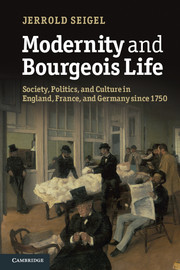 Modernity and Bourgeois Life
Modernity and Bourgeois Life Book contents
- Frontmatter
- Contents
- Illustrations
- Preface
- 1 Introduction: ends and means
- Part I Contours of modernity
- 3 Monarchical centralization, privilege, and conflict: France
- 4 Localism, state-building, and bürgerliche Gesellschaft: Germany
- 5 Modern industry, class, and party politics in nineteenth-century England
- 6 France and bourgeois France: from teleocracy to autonomy
- 7 One special path: modern industry, politics, and bourgeois life in Germany
- Part II Calculations and lifeworlds
- 9 Men and women
- 10 Bourgeois morals: from Victorianism to modern sexuality
- 11 Jews as bourgeois and network people
- Part III A culture of means
- 13 Bourgeois and others
- 14 Bourgeois life and the avant-garde
- 15 Conclusion
- Notes
- Index
3 - Monarchical centralization, privilege, and conflict: France
Published online by Cambridge University Press: 05 June 2012
- Frontmatter
- Contents
- Illustrations
- Preface
- 1 Introduction: ends and means
- Part I Contours of modernity
- 3 Monarchical centralization, privilege, and conflict: France
- 4 Localism, state-building, and bürgerliche Gesellschaft: Germany
- 5 Modern industry, class, and party politics in nineteenth-century England
- 6 France and bourgeois France: from teleocracy to autonomy
- 7 One special path: modern industry, politics, and bourgeois life in Germany
- Part II Calculations and lifeworlds
- 9 Men and women
- 10 Bourgeois morals: from Victorianism to modern sexuality
- 11 Jews as bourgeois and network people
- Part III A culture of means
- 13 Bourgeois and others
- 14 Bourgeois life and the avant-garde
- 15 Conclusion
- Notes
- Index
Summary
The mosaic of privilege
If England was at once the most bourgeois country and the least, a correspondingly revealing paradox for France was that the country which became the homeland of modern revolution was also the one whose transformation between the eighteenth century and the twentieth was the slowest and least complete. The nation that provided the exemplary instance of large-scale social and political upheaval and gave the term “bourgeois” to the world might be expected to be a trailblazer in modernity and an exemplary case of fundamental and sweeping social change, but it was neither. The Revolution changed much to be sure but it left many features of French life intact, as Alexis de Toqueville famously argued. No major European economy grew as slowly and with so little transformative impact on daily life, at least until the last years of the nineteenth century, as did the French.
A few statistics tell the story. In 1880 approximately half of the active population of France was still working in agriculture. In England that number had declined to 25% by 1840, forty years earlier, a level that France would not reach until the 1950s. In 1861 only 11% of French people lived outside the Département where they had been born; in 1881 the number was still only 15%. Save for Paris and a few other cities, it was only after 1850 that urban population grew faster than that of the country as a whole; until then cities expanded at a rate equal to or below that of France overall. Even at the end of the nineteenth century the country’s urban fabric exhibited a pattern remarkably continuous with the Old Regime. Of the fifteen French cities with a population greater than a hundred thousand in 1906, only two, Roubaix and Saint-Étienne, had what Jean-Pierre Daviet calls “a character broadly determined by the industrial urbanism we associate with the nineteenth century.” All the others had already figured among the country’s biggest cities before the Revolution, continuing to grow largely on their earlier foundations, so that “the nineteenth century gave clearer shape to a pre-existing urban hierarchy, without really creating its own.”
- Type
- Chapter
- Information
- Modernity and Bourgeois LifeSociety, Politics, and Culture in England, France and Germany since 1750, pp. 73 - 113Publisher: Cambridge University PressPrint publication year: 2012
